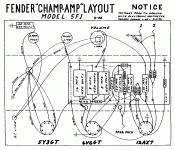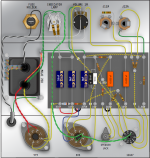How y'all doing?
I've got a Fender Champ 5F1 guitar amp that has a crispy 22k ohm resistor on the speaker jack.
The amp now buzzes a lot, varies with the loudness pot. Funny thing is that it buzzes loudest from mid to high volume, decreases when the pot is turned to the loudest setting. That's usually too loud.
Does this sound like it could be a bad resistor? I'm going to go ahead and change the resistor, just wanted to get some ideas in case this isn't the problem. The crispy resistor is the only thing that visually looks bad. I tried different tubes.
Thanks!
I've got a Fender Champ 5F1 guitar amp that has a crispy 22k ohm resistor on the speaker jack.
The amp now buzzes a lot, varies with the loudness pot. Funny thing is that it buzzes loudest from mid to high volume, decreases when the pot is turned to the loudest setting. That's usually too loud.
Does this sound like it could be a bad resistor? I'm going to go ahead and change the resistor, just wanted to get some ideas in case this isn't the problem. The crispy resistor is the only thing that visually looks bad. I tried different tubes.
Thanks!
Attachments
That is the negative feedback resistor. It should not be crispy. Seems like there is more going on with your amp.
Thanks for your replies!
I failed to mention that the resistor is crispy because when I put the circuit board together, I omitted two wires between the two caps on the top left.
This amp was built from a kit and a schematic wasn't supplied, only the attached drawing. I downloaded a schematic later.
I failed to mention that the resistor is crispy because when I put the circuit board together, I omitted two wires between the two caps on the top left.
This amp was built from a kit and a schematic wasn't supplied, only the attached drawing. I downloaded a schematic later.
Attachments
What company in their right mind would sell a kit with no schematic? Seems like a recipe for disaster to me.
That's what I was thinking. The schematic wasn't included with the instruction manual, but it is easy to find on the website.
I'll replace that crispy resistor and check all the voltages this weekend. I can break out the long table in the garage and disassemble the amp, listen to some good music while working.
I built any number of Heathkits and Eico kits over the years. They always included a schematic, but the schematic was never a part of the building process. If they show a layout, then there will not be confusion over what goes where, ie not schematic interpretation needed.
This is the first time I assembled a kit without a schematic. It would have helped because I don't think I would have missed the two connections between the caps if I had compared the layout to the schematic.
My manager recently called a floorplan drawing a schematic, and when I mentioned moving the machine tools, she said don't forget the lathes and mills.
My manager recently called a floorplan drawing a schematic, and when I mentioned moving the machine tools, she said don't forget the lathes and mills.
To those of us who read schematics, they are of course useful. But if you missed a connection that was in fact present on the layout, that isn't the drawing's fault.
What company in their right mind would sell a kit with no schematic? Seems like a recipe for disaster to me.

Yes, Enzo, I was doing this with my son. We both missed the connections. We did troubleshoot and find the problem by comparing the schematic to the layout.
Yes, Printer2, you are correct! I even HAVE a CeriaTone amplifier very similar to the one you showed; I did the same thing as Duke58 and just downloaded the schematic (Marshall) from the internet. The CeriaTone amps are fine amplifiers and I love my 18-watter (though their prices have skyrocketed since I bought mine), but their lack of providing schematics still pisses me off! They AREN'T in their right mind!😡
Last edited:
Sorry. I thought I had, but apparentely I didn't pay enough attention and missed the important bit.
@pcardoso73 - I learned electronics when I was in the military long ago, then earned a BSME degree about a decade later and this is the first guitar amp I put together. Military training teaches electronics basics, then spends the rest of the time where you learn to troubleshoot and maintain specific electronics gear. You have to learn how to do this in the middle of nowhere, and my training was long enough ago that we didn't have PCs and the internet, we had paper schematics.
Decided to build this guitar amp with my son and gave it to him as a Christmas gift, but I was not used to working from the drawing vs a schematic. You can download a schematic from the company website. I wasn't blaming anyone/anything for the fried resistor, that was 100% my fault since I should have loaded down the schematic before starting to assemble the kit.
The amp is still working fine, being used regularly by my son. It's a very good size and weight, perfect for gigs and he prefers it over the Vox amp he owns because it's not as heavy and bulky.
Decided to build this guitar amp with my son and gave it to him as a Christmas gift, but I was not used to working from the drawing vs a schematic. You can download a schematic from the company website. I wasn't blaming anyone/anything for the fried resistor, that was 100% my fault since I should have loaded down the schematic before starting to assemble the kit.
The amp is still working fine, being used regularly by my son. It's a very good size and weight, perfect for gigs and he prefers it over the Vox amp he owns because it's not as heavy and bulky.
We all miss stuff occasionally. On the software, no idea if they use it but you might find this of use.Sorry. I thought I had, but apparentely I didn't pay enough attention and missed the important bit.
https://diy-fever.com/software/diylc/
- Home
- Live Sound
- Instruments and Amps
- Fender 5F1

